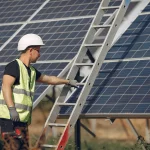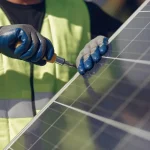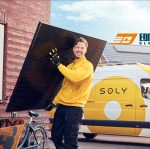Category:
Blog
Is a Solar Powered Air Conditioner Powerful Enough?
Sustainable energy solutions like a solar powered air conditioner, are becoming more and more popular.
Category:
Sustainable energy solutions like a solar powered air conditioner, are becoming more and more popular.
Just imagine what it feels like to use the sun’s powerful rays to cool your home. With the growth of this option, it’s now clear that we need to talk about just how they work and what they have to offer. So whether you’re thinking about getting one for your home or want to learn more, this guide was made for you.
Solar powered air conditioners are truly changing the way we cool our homes. When we use solar power with these systems, we reduce our dependence on fossil fuels while also lowering the electricity bill. Below, we’ll get into the basics of just how these systems work and the types available:
A solar-powered AC relies on PV (photovoltaic) panels that capture sunlight. These panels convert it into DC (direct current) electricity. DC is then turned into AC (alternating current) by an inverter that powers the air conditioning unit. There are some systems that also feature battery storage to save excess energy for nighttime or cloudy days.
As we mentioned above, PV panels are made up of many solar cells that absorb sunlight and turn it into electricity. Usually, these panels are installed on rooftops or other areas that get the most sun exposure to capture the most energy.
Just as we touched base on above, the solar inverter is a key part of the system that changes the DC current electricity from the PV panels into AC electricity. This powers household appliances, including air conditioners.
Solar battery storage systems work by saving the excess power that’s generated during the day for use at night or on cloudy days as stated above. This means that your solar powered air conditioner can work even without any direct sunlight.
Solar powered air conditioners come in different types. The main types include DC-only units, hybrid systems, and split systems. We’ll discuss what each of these bring to the table below:
With a DC-only unit, it runs solely on direct current from the solar panels. These units are generally used in off-grid locations where there’s no access to the electricity grid. DC-only units are perfect for remote areas and provide reliable cooling with no need for an external power source.
With a hybrid system, it can switch back and forth between solar and grid power. This ensures that they keep running even when the solar power just isn’t enough. With a hybrid system, you get flexibility and reliability, which makes them a popular choice for both homes and businesses.
The split system is commonly used as a solar powered air conditioner in homes. These consist of an indoor unit and an outdoor unit connected by refrigerant lines. These systems can be powered by solar energy and offer efficient and effective cooling for the home.
When thinking about solar AC units, efficiency and performance are key. Solar air conditioners are rated with metrics like the Seasonal Energy Efficiency Ratio (SEER) and Energy Efficiency Ration (EER). Knowing these ratings can help you choose a system that meets your cooling needs and saves energy.
SEER measures an air conditioner’s cooling output over a season divided by its energy use. Modern units typically range from 13 to 21 SEER. Higher SEER ratings mean better efficiency.
EER measures efficiency at peak load. Understanding these ratings helps you pick an efficient solar powered air conditioner. These ratings typically range between 8 and 12. Higher ratings indicate more efficient units. You can find out more about SEER and EER here.
There are many things that can affect the efficiency of a solar AC unit. Let’s take a look at some of these below to get a better understanding so that you can optimise your system’s performance and maximise energy savings:
The amount of sunlight received in your location will impact the energy generated by your solar panels. When it comes to solar-powered air conditioning, areas with more sunlight will have higher energy yields, and a more efficient solar AC unit.
The direction and angle of your solar panels matter when it comes to capturing the most energy. For the UK, the optimal angle for solar panels to capture the most sunlight depends on the latitude of your location, with room for seasonal adjustments.
Higher temperatures can slightly reduce the efficiency of solar panels. Cooler panels work at maximum rated efficiency, while very hot panels can lose 10-15% efficiency. Good ventilation can help maintain the panel’s efficiency.
For a solar powered AC unit to run properly, the correct installation and maintenance of even the solar panels are crucial. This is going to maximise the efficiency and longevity of the entire system. For the panels, the installation process involves a careful assessment of your roof layout, securing the necessary permit, and professional mounting. This way, everything is set up correctly right from the start. Regular maintenance, like cleaning, and occasional inspections, is a great way to keep your system running smoothly for years to come. Curious about the breakdown of costs? Check out our comprehensive guide on solar panel installation cost to find out more.
Installing solar powered AC units starts with a thorough site assessment. This is to make sure that there’s enough sunlight and space for PV panels. Then, the process will involve mounting the panels, setting up the solar powered air conditioner, and connecting the inverter and batteries. To be sure everything is done safely and correctly, a professional is necessary. Let’s go over these in a bit more detail:
During the site assessment that checks for enough sunlight and space for the PV panels, factors such as roof orientation, shading, and structural integrity are taken into consideration to determine the best solar panel placement.
The installation process includes several steps, like mounting PV panels, installing the solar AC unit, and connecting the inverter and batteries. We’ll explore this in more detail below:
PV panels must be mounted securely to a roof or ground structure with the most sun exposure. A trusted professional is the best person to perform this job.
At Soly, we only partner with reputable and certified solar panel installers to ensure we meet the highest standards of safety, quality, and customer satisfaction. Extensive experience along with the ability to follow the best industry practices is key when it comes to proper mounting so that the panels are stable and the most energy is captured.
To minimise energy loss, the inverter needs to be installed close to the PV panels. It’ll convert the DC electricity generated by the panels into the AC electricity (as we mentioned earlier), which is used by solar AC systems.
To get the most out of your solar energy system, proper battery setup is key. A solar battery allows you to store electricity generated by your solar panels or directly from the energy grid, so you’ll have power when you need it the most. So, to maximise the lifespan of your battery, be sure to store it in a cool, dry place. This setup helps store excess energy generated during the day for use at night or during cloudy conditions (so you can be more self-sufficient and less reliant on the energy grid). At SOLY, we offer solar batteries along with solar panels to help meet your energy needs.
When it comes to a solar powered air conditioner, regular maintenance will keep the unit running efficiently. This includes things like cleaning the panels, checking electrical conditions, and monitoring battery health. Proper maintenance can extend your system’s lifespan and ensure it performs well. Let’s look at these below:
So, do solar panels need cleaning? When you get your panels from Soly, you can rest easy, knowing that they are self-cleaning! This is a major advantage of our solar panels. However with many other solar panels, they do need cleaning. Dust and debris can reduce the efficiency of your PV panels.
If you have panels that require cleaning, please be sure to do it safely by using deionised water and a soft brush or sponge. Don’t use abrasive material or harsh chemicals. These can damage your panels.
Keep all electrical connections tight and corrosion-free for efficiency and safety in your solar AC unit. Loose or corroded connections can lead to great energy losses and major safety risks too.
Be sure to regularly check the connections, tighten any loose screws or bolts. If you notice any signs of corrosion, it may be a good idea to schedule a professional inspection.
Monitor the condition of your batteries and then replace them when necessary. Proper servicing of the batteries is required for perfect, reliable operations of the solar power air conditioners.
For solar AC units, the best way to maintain them is by scheduling regular maintenance. These regular checks and upkeep can prevent minor issues from becoming much bigger ones. This ensures your solar AC unit runs smoothly all-year-long. Here’s some guidelines:
Daily/Weekly:
Monthly:
Annually:
This routine will help you get the most out of your solar powered air conditioner, providing reliable and efficient cooling for years to come.
It’s important to understand the costs involved with solar air conditioning. While the initial investment upfront may be quite significant, things like financial incentives and long-term savings can make it worthwhile.
The initial investment of solar air conditioning includes the cost of the PV panels, inverters, batteries, and installation labour. It’s important to invest in high-quality components and professional installation to ensure long term savings, reliability, and efficiency.
A typical cost breakdown for a solar powered air conditioner includes the following:
Total: £10,000
It’s important to keep in mind that these figures vary based on the size of the solar AC unit. However, this gives a general idea of the costs that are involved.
A professional installation of a solar powered air conditioner ensures the system is both safe and efficient. While this adds to the initial cost, this is going to maintain the long-term reliability of the solar AC unit.
There are many financial incentives that can help offset the initial costs of installing both panels and a solar powered air conditioner. These include tax credits and incentive programs that are aimed at promoting renewable energy adoption.
Over time, the long-term savings on the electricity bills and potential income from selling excess energy back to the grid can make your entire solar energy system a financially sound investment.
Solar power AC units can greatly reduce or even eliminate your electricity bills. This is especially true in sunny regions. By generating your own power, you’re able to enjoy substantial savings and rely less on the power grid.
With net metering, you have the opportunity to sell any excess energy produced by your solar system back to the grid. This gives you the opportunity to potentially earn credits on your utility bill. This can boost your long-term savings as well, making your solar investment even more attractive.
While there are many benefits of getting a solar power air conditioner, there are also challenges to take into consideration. Let’s explore these below so you can make the right decision for you:
Perhaps one of the greatest barriers to getting a solar powered air conditioner is the initial cost. However, those financial incentives we discussed earlier, as well as financing options can really help offset those costs and make the investment much more doable.
Adequate energy storage is a must for the reliable operation of a solar powered AC unit. This is especially necessary at night or when it’s cloudy outside. Advanced solar battery technologies and proper system design, such as those from SOLY, can ensure sufficient storage capacity.
With a strictly solar powered AC unit, it’s going to rely on weather. This can affect the performance greatly. Hybrid systems, on the other hand, can switch back and forth to grid power. Proper planning can also help with this issue.
Switching over to solar air conditioners is an awesome way to help our planet. When we harness the power of the sun, these systems cut down on the need for fossil fuels. In turn, this reduces greenhouse gas emissions. This paves the way for a cleaner, greener world.
When you choose to use solar energy to power your AC unit, you’re making a sustainable choice. Unlike fossil fuels, solar energy is abundant and constantly replenished. With a solar powered system you’re not just saving money, you’re supporting a transition to renewable energy.
In the long-term, just think about a world where most air conditioners run solar powered. This could drastically reduce our reliance on fossil fuels. In time, this shift could lead to cleaner air, fewer climate-related issues and a healthier planet for future generations.
Choosing the right size solar powered AC unit is vital to get the most out of it. This guide will walk through how to calculate your energy needs and make sure your solar panels can meet those demands, so you can stay cool without overspending.
Start by figuring out how much energy your air conditioner uses. This involves looking at its BTU (British Thermal Unit) rating and converting that to kilowatts (kW). This will help you match the right amount of solar power to your energy consumption.
To convert BTUs to kilowatts, simply divide the BTU number by 3,412 (since 1 kW = 3,412 BTU). For example, if your air conditioner is rated at 12,000 BTUs, you’ll need about 3.5 kW of power. This conversion is key to understanding your energy requirements.
Next, calculate your daily energy usage. Multiply your air conditioner’s power requirement (in kW) by the number of hours it runs each day. This gives you the total energy consumption in kilowatt-hours (kWh). This part is necessary to determine the solar panel output you’ll need.
After that, you’ll need to determine how much energy your solar panels can generate. This will depend on their wattage and the number of peak sun hours your location gets. Understanding this will help you make sure that your solar panels meet your solar AC unit’s demands.
There’s this common misconception that solar panels only work in direct sunlight. Though it may be true that the maximum efficiency peaks when the sun is at its brightest, solar panels can produce energy even on those cloudy days!
Higher efficiency panels produce more energy per square foot. This means you need fewer panels to generate the same amount of power, saving space and potentially reducing costs. This is a vital factor when designing an effective solar air conditioning system.
To make sure that your solar panels can meet the demands of your solar powered AC, calculate the total watt-hours needed and compare that to your panels’ daily output. This step is necessary to ensure you have enough power to keep your home nice and cool.
To find out how many solar panels are needed for an AC unit, use this simple formula: Total Watt-hours (Wh) ÷ Solar Panel Daily Watt-hours (Wh) = Number of Solar Panels. For example, if your air conditioner requires 3,500 Wh per day and each panel produces 250 Wh daily, you’ll need 14 panels. This calculation helps you plan your system accurately.
When it comes to solar panels for AC units, be sure to account for potential inefficiencies by slightly oversizing your system. This buffer ensures that your solar AC runs smoothly even when sunlight conditions aren’t perfect, maintaining consistent performance.
As we mentioned briefly earlier, there are financial assistance programmes such as government grants for solar panels, UK residents can look into. These programmes are designed to make solar installations accessible and affordable to all. Here’s a look at what is offered across the globe when it comes to solar assistance:
The UK government provides different grants and tax incentives to encourage more people to move toward the adoption of solar energy. For example, The Smart Export Guarantee (SEG) gives you a way to earn money by exporting excess solar energy back to the grid. This makes the switch to solar much more financially viable.
Just like the national incentives, many local authorities are offering their own schemes to promote solar energy. These include grants, rebates, and other financial incentives. It’s definitely worthwhile to research what’s available in your area so you can maximise your savings.
Solar energy loans, such as green energy loans, are a great way to finance your solar installation. They often come with favourable interest rates and allow you to spread the cost over several years, making the initial investment of a solar AC unit and the entire solar powered system more manageable.
Let’s recap what we’ve learned about solar powered air conditioners:
Solar powered air conditioning is an excellent way to stay cool while being gracious to our planet. They are indeed the future of sustainable cooling and are growing in popularity as the technology continues to evolve.
At Soly, we believe in solar AC and the things solar panels and a solar battery can do for these eco-conscious cooling solutions. When you’re ready to make the switch, be sure to explore our solar panels and storage batteries. It’s time to join the solar revolution and calculate your savings today!



